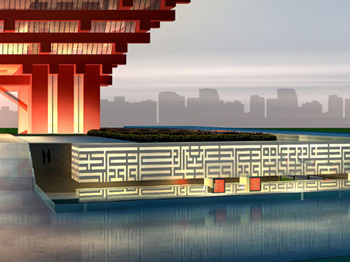Draped in red cloth, China's pavilion at the 2010 World Expo is
at first glance a very obviously Chinese structure.
When the mysterious red veil is lifted, however, it is revealed
as a complex structure that celebrates a diverse range of
traditional Chinese elements, including architecture, calligraphy,
gardening and urban planning.
Standing in the central location of the Expo site at 63 meters
tall, triple the height of any other pavilion, the structure
certainly will become a fine exhibit for Shanghai to present to the
world ahead of the Expo opening.

The main structure of the China Pavilion, "The Crown of the
East," has a distinctive roof, made of traditional dougong or
brackets, which has a history dating back more than 2,000
years.
The dougong style features wooden brackets fixed
layer upon layer between the top of a column and a crossbeam. This
unique structural component of interlocking wooden brackets is one
of the most important elements in traditional Chinese
architecture.
Dougong was widely used in the Spring and Autumn Period (770
BC-467 BC). After the Song Dynasty (960-1279), the bracket sets
became more ornamental than structural when used in palatial
structures and important religious buildings.
Ancient craftsmen cut the wooden pieces to fit together so
perfectly that no glue or fasteners were necessary. Today, visitors
can still see these distinct brackets in the Forbidden City and
Summer Palace in Beijing.
The six-layer, 30-meter-high dougong roof is actually the
exhibition area of the Chinese national pavilion. The 56 brackets
used in the roof symbolize the 56 minority ethnic groups in
China.
The top of the roof features a Sudoku grid, which was a
traditional urban planning feature in ancient Chinese cities such
as Xi'an (Shaanxi Province) and Beijing.
When the sun shines into the pavilion, there will be a smaller
Sudoku shadow in the semi-open square on the ground floor of the
structure.
Below the main structure, there will be a 45,000-square-meter
joint pavilion featuring the displays from local provinces, cities
and regions.
A special kind of zhuan, or seal style of Chinese calligraphy,
is to be used to write the names of local participants on the
outside wall of the pavilion.

The strokes of this kind of calligraphy will be "folded" into
horizontal or vertical lines, to give a window-like appearance.
The Jiangsu Province style of garden landscaping has been chosen
for the pavilion.
This style is commonly seen in cities such as Yangzhou or
Suzhou, which are both in neighboring Jiangsu Province.
The Jiangnan (region south of the Yangtze River) gardens feature
delicate arrangements, pavilions and tranquil ponds, which will
give visitors a relaxing sanctuary from the urban environment
outside.
But the pavilion design has already attracted some criticism,
with critics saying that the information conveyed through the
design is too complicated and too symbolized.
"A striking project certainly will trigger different opinions,"
said He Jingtang, a member of the Chinese Academy of Engineering
and chief designer of the China Pavilion project.
Defending the design from accusations that it was too esoteric,
the nearly 70-year-old professor described it as "a statue of China
standing in the garden of a city."
Bureau of Shanghai World Expo Coordination Deputy Director,
Huang Jianzhi, said the pavilion is reminiscent of China at first
sight, "striking and memorable."
The new pavilion will be a new landmark for Shanghai and a
legacy for the rest of China, the organizers said.
The China Pavilion includes a national pavilion, a joint
pavilion for provinces and cities, and separate pavilions for Hong
Kong, Macau and Taiwan. Provinces and cities in the joint pavilion
will have a 600-square-meter space and are required to submit their
preliminary exhibition plans before April.
Construction has started on all the permanent structures in the
Expo site, including the China Pavilion.
The pavilion will be converted into a museum for Chinese history
and culture after the Expo closes in 2010.
(Shanghai Daily February 18, 2008)